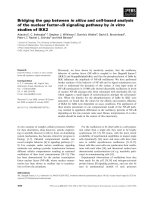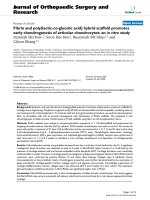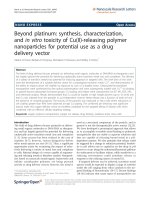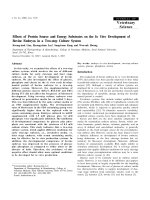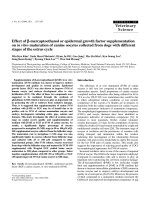The in vitro study of streptomyces as biocontrol agent against the ground nut stem rot fungus, Sclerotium rolfsii (Sacc.)
Bạn đang xem bản rút gọn của tài liệu. Xem và tải ngay bản đầy đủ của tài liệu tại đây (195.05 KB, 7 trang )
Int.J.Curr.Microbiol.App.Sci (2020) 9(11): 2013-2019
International Journal of Current Microbiology and Applied Sciences
ISSN: 2319-7706 Volume 9 Number 11 (2020)
Journal homepage:
Original Research Article
/>
The in vitro Study of Streptomyces as Biocontrol Agent against
the Ground nut Stem Rot Fungus, Sclerotium rolfsii (Sacc.)
K. Yamunarani1, A. Kalyanasundaram2* and M. Muthamizhan3
1
Plant Pathology, 2Agricultural Entomology, Agricultural College and Research Institute
Eachangkottai, India
3
Department of Plant Pathology, Coimbatore, India
*Corresponding author
ABSTRACT
Keywords
Sclerotium rolfsii,
Groundnut stemrot,
Streptomyces
Article Info
Accepted:
15 October 2020
Available Online:
10 November 2020
Native isolates of groundnut stem rot casual organism, Sclerotium rolfsii Sacc. were
collected from major groundnut growing areas of Tamil Nadu. Selected isolates were
screened, characterized and identified the virulent isolate. Morphology and spore structure
of isolated antagonists, GNRAJK1 and GNRAVR14 were studied. The genus and species
level of the antagonists was identified as Streptomyces violaceusniger and Streptomyces
exfoliatus. The antagonistic activities of Streptomyces violaceusniger were found to be
effective in reducing the mycelial growth, sclerotial formation and germination. The
Streptomyces violaceusniger treated cultures were shown reduced mycelial growth
(85.00%) and reduced sclerotial production (87.86%). The effect of crude antibiotics and
volatiles of S. violaceusniger, S. exfoliates and P. fluorescens were studied against S.
rolfsii, the results revealed the percent mycelial growth reduction of S. rolfsii over control
by S. violaceusniger and S. exfoliatus were 69.56 and 66.17 per cent respectively. This
study provides a theoritical and practical explanation of an antagonist explored for control
of stem rot caused by Sclerotium rolfsii.
Introduction
Groundnut (Arachis hypogaea L.) is an
important oilseed crop of India and it is called
as the ‘king’ of oilseeds. Groundnut is
cultivated in about 40.12 lakh ha in 2018-19
and production is 37.70 lakh tonnes and with
an average yield 931 kg/ha respectively. In
spite of their important positions in national
agricultural economy and the multiplicity of
crops and crop growing situations, the
countries out of oilseeds are lagging far
behind the requirement. The groundnut
production is constrained by various factors
and the major constraints include as frequent
drought stress, low input use and socio
economic infrastructure and higher incidence
of disease and pest attack.
Though the groundnut is attacked by number
of diseases, the soil borne fungal disease,
Aspergillus niger Van Tieghem, Sclerotium
rolfsii Sacc and Rhizoctonia bataticola Taub
have been reported to cause severe seedling
2013
Int.J.Curr.Microbiol.App.Sci (2020) 9(11): 2013-2019
mortality resulting patchy crop and reduced
yield ranging from 25–40 per cent (Ghewande
et al., 2002). Among soil borne pathogen
Sclerotium rolfsii has wide host range, profile
growth and ability to produce persistent
sclerotia contribute the large economic losses.
The excessive use of chemical fungicides in
agriculture has led to deteriorating human
health,
environmental
pollution
and
development of pathogen resistance to
fungicide. Microbial antagonists are widely
used for the biocontrol of fungal plant
diseases due to lack of induction of pathogen
resistance and reduction of chemical
fungicide residues in the environment.
Understanding the pathogen, developing and
relay on single antagonism become
challengeable and give way to explore and
identify the suitable alternate antagonist
against the disease. Streptomyces are common
inhabitants of rhizosphere and act as
beneficial microorganisms for plant growth
and development (Gopalakrishnan et al.,
2013).
Materials and Methods
Effect of Streptomyces and Pseudomonas on
mycelial growth and sclerotial Production
of S. rolfsii under in vitro condition
The identified species of Streptomyces
violaceusniger, Streptomyces exfoliates and
Pseudomonas fluorescens bacteria were
streaked in a four cm line (1 cm away from
the edge of the plate) on each PDA medium.
A nine mm mycelial disc of Sclerotium rolfsii
was placed to the most distal point of the Petri
dish perpendicular to the bacterial streak
(Vidhyasekaran et al., 1997) and then plates
were incubated at room temperature for four
days and mycelial growths of the pathogen
and sclerotial production were measured.
Efficacy of the culture filtrates of the
antagonists against mycelial weight of S.
rolfsii
Potato dextrose and King’s B broths were
prepared and distributed in 250ml conical
flasks @ 100 ml per flask and sterilized at
1.04 kg / cm2 pressure for 20 minute. The
fungal and bacterial antagonists were
inoculated into the sterilized potato dextrose
and King’s B broth and incubated for ten and
two days respectively at room temperature
(282◦C).
The cell free culture filtrates of the
antagonistic organism were prepared by
centrifugation of culture filtrates of the
respective organism at 8000 rpm for 20
minute. Then 10 ml of the cell free culture
filtrate of each of the antagonists were added
to 90 ml of potato dextrose broth (PDB)
separately and sterilized in autoclave at 1.04
kg/ cm2 pressure for 20 minute. A nine mm
disc of actively growing of S. rolfsii was
inoculated into each flask under aseptic
conditions and incubated at room temperature
(282◦C) for one week. Then the mycelial mat
of the pathogen were removed on pre weighed
filter paper, air dried and weighed separately.
Potato dextrose and King’s B broths without
any culture filtrates served as control. Three
replications were maintained for each
treatment. The results were expressed as
mycelial dry weight of pathogen in gram.
Antibiotics
Extraction
of
crude
antimicrobial
compounds from Streptomyces spp.
The Streptomyces violaceusniger and
Streptomyces exfoliates were grown in yeast
extract malt extract medium at 282ºC for
seven days. Five ml of sterile distilled water
was added to each sub cultured slants
scrapped with a sterile needle and transferred
2014
Int.J.Curr.Microbiol.App.Sci (2020) 9(11): 2013-2019
to the inoculum medium. The inoculum was
incubated on a rotary shaker for 4-5 days at
37ºC. After sufficient growth was obtained,
the inoculum was incubated at 28ºC for 72h.
After the production period was over, the
medium was centrifuged. The broth was
separated. The mycelium was dried. The
mycelial cake was extracted with methanol.
The extracts were tested by poisoned food
technique method against S. rolfsii. The
separated broth samples were also tested for
their anti microbial activity using poisoned
food technique (Trejo- Estrada et al., 1998).
Volatile compounds
This study was performed by paired Petri dish
technique (Laha et al., 1996). Two days old
fresh cultures of S. violaceusniger and S.
exfoliatus were uniformly streaked on yeast
malt extract medium in a Petri dish. In
another set, 9 mm diameter of mycelial disc
cut from a four day old culture of S. rolfsii
was placed at the centre of the PDA plate.
Then the PDA plate with the pathogen (upper)
was paired with the Petri dish containing the
bacterial antagonist (lower) and sealed with
parafilm. Dishes inoculated with S. rolfsii
alone, paired with uninoculated yeast malt
extract medium plate served as control. Three
replications were maintained for each
treatment. The paired plates were incubated at
room temperature (282ºC) and colony
diameter of S. rolfsii was measured at 5 days
after incubation.
Antibiotics
Extraction
of
crude
antimicrobial
compounds from antagonistic bacteria
Cultures of P. fluorescens were grown at
282◦C in Pigment Production medium
(PPM) (Peptone-20g/l, Glycerol-20g/l, NaCl5g/l, KNO3-1g/l, pH-7.2, Distilled Water1litre). The cultures were grown in PPM for
five days and were centrifuged at 5000 rpm.
The supernatants were adjusted to pH 2.0
with conc. HCl and it was extracted with an
equal volume of benzene. The Benzene layer
was subjected to evaporation in water bath.
After evaporation, the residues were
resuspended in 0.1N NaOH.
Extraction and isolation of Phenazine
Cultures of P. fluorescens were grown in
nutrient broth at 30◦C on a rotary shaker. The
cells were collected by centrifugation at 3500
rpm for seven minutes. The pellets were
suspended in pigment production broth and
then incubated on a rotary shaker for four
days at 30◦C. The antibiotic phenazine-1carboxylic acid (PCA) was isolated as per the
procedure described by Rosales.
The antibiotic was separated in to respective
fractions after acidifying the culture filtrate
with 1N HCl to pH 2.0 and then extracting the
culture filtrate with an equal volume of
Benzene (Phenazine). Then the benzene phase
was extracted with 5 per cent NaHCO3.
Phenazine-1-carboxylic acid was recovered
from
the
bicarbonate
layer
while
oxychlororaphine remained in the benzene
layer. The bicarbonate fraction was extracted
once again with benzene to recover phenazine
from bicarbonate fraction. The antibiotic was
air dried and dissolved in methanol.
Extraction of 2, 4- diacetylphloroglucinol
(2, 4 -DAPG) (Rosales et al., 1995)
P. fluorescens were grown in 100ml of
Pigment Production broth for four days on a
rotary shaker at 30◦C. The fermentation broth
was centrifuged at 3500 rpm for five minute
in a tabletop centrifuge and the supernatant
was collected. It was acidified to pH 2.0 with
1N HCl and then extracted with an equal
volume of ethyl acetate. The ethyl acetate
extracts were reduced to dryness in vacuo.
The residues were dissolved in methanol.
2015
Int.J.Curr.Microbiol.App.Sci (2020) 9(11): 2013-2019
Effect of 2,4 - DAPG and Phenazine on the
growth of S. rolfsii
The crude residues of Phenazine and 2, 4 DAPG were evaluated at 0.1% and 0.5%
concentration for their inhibitory effect on the
mycelial growth of S. rolfsii by poisoned food
technique (Schmitz, 1930).
Effect of volatile compounds
antagonistic bacterium
of
the
This study was performed following paired
Petri dish technique. Two days old fresh
cultures of P. fluorescens was uniformly
streaked on King’s B medium in a Petri dish.
In another set 9 mm diameter of mycelial disc
cut from a four day old culture of S. rolfsii
was placed at the centre of the PDA plate.
Then the PDA plate with the pathogen (upper)
was paired with the Petri dish containing the
bacterial antagonist (lower) and sealed with
parafilm. Dishes inoculated with S. rolfsii
alone, paired with uninoculated King’s B
medium plate served as control. Three
replications were maintained for each
treatment. The paired plates were incubated at
room temperature and colony diameter of S.
rolfsii was measured at 5 days after
incubation (Laha et al., 1996).
Results and Discussion
Effect of Streptomyces and Pseudomonas on
mycelial growth and sclerotial production
of S. rolfsii under in vitro
Among the bacterial antagonists, the
identified species S. violaceusniger was found
to be highly effective in reducing the mycelial
growth (86.45 per cent) than S. exfoliatus
(83.06 per cent) and P. fluorescens (28.89 per
cent). The sclerotial production was very less
37.00 numbers with highest reduction of
87.86 per cent over control in P. fluorescens
treated plates. The S. violaceusniger and S.
exfoliatus treated plates were shown 83.30 per
cent and 79.66 per cent reduction of sclerotial
production respectively.
Effect of volatiles of bacterial antagonists
on growth of S. rolfsii
The volatile studies also revealed that the
mycelial growth of S.rolfsii was reduced
69.56 per cent by S. violaceusniger and 66.17
per cent by S.exfoliatus with the mycelial
diameter of 2.70 cm and 3.00 cm respectively.
Similar observations were also made by
earlier workers Geetha and Vikineswary
(2002) who reported that S.violaceusniger
G10 showed strong antagonism against
F.oxysporum f.sp. cubense by producing
extracellular antifungal metabolites. The
volatiles of other bacterial antagonist P.
fluorescens inhibited the mycelial growth by
54.57 per cent (Table 1).
The volatile studies of bacterial antagonists
were conducted since the production of
volatile cyanide is very common in
rhizosphere Pseudomonas (Dowling and
O’gara, 1994). Laha et al., (1996) stated that
the volatile cyanogenic metabolites produced
by P. fluorescens suppress the growth of S.
rolfsii. Sharifi-ehrani and Omati (1999)
observed a strong inhibitory effect on
P.capsici by rhizosphere bacteria P.
fluorescens and B. subtilis by production of
volatiles. Volatile substances derived from
Streptomyces sp. and other species of
actinomycetes prevent mycelium growth and
inhibit spore germination of different fungi
(Kai et al., 2008). In another research, effects
of volatile substances of S.globisporus were
examined on spore germinating and mycelium
growth Penicillium italicum and infected
fruits. Among 41 volatile substances of this
bacterium, Dimethyl disulfide and Dimethyl
trisulfide have high inhibiting effects against
fungus (Li et al., 2010).
2016
Int.J.Curr.Microbiol.App.Sci (2020) 9(11): 2013-2019
Table.1 Effect of volatiles of bacterial antagonists on growth of S. rolfsii
S.N
o
Isolate
*Mycelial
diameter
(cm)
4.03
2.70
3.00
8.87
0.59
P. fluorescens
S. violaceusniger
S. exfoliatus
Control
CD (P=0.05)
1
2
3
4
Per cent
reduction over
control
54.57
69.56
66.17
-
Nature of growth of the pathogen
Thin linear mycelial strands
Thin linear mycelial strands
Thin linear mycelial strands
Profused growth
* Mean of three replications
Table.2 Effect of crude antibiotics of Streptomyces sp. on S. rolfsii
S. No
Antibiotics
Brothextract
Streptomyces
violaceusniger
Streptomyces exfoliates
Streptomyces
violaceusniger
Streptomyces exfoliatus
Control
Methanolic
extract
CD (P= 0.05)
Antibiotics
Concentration
AxC
Mycelial diameter (mm)
Concentration
Concentration
0.1%
0.5%
27.66
14.40
Per cent reduction over control
Concentration
Concentration
0.5%
0.1%
69.20
84.00
20.33
23.00
10.40
11.33
77.44
74.40
88.40
87.40
18.00
90.00
12.33
90.00
80.00
--
86.30
--
= 1.85
= 1.17
= 2.62
Table.3 Effect of crude antibiotics of Pseudomonas fluorescens on S. rolfsii
S. No.
1
2
3
Antibiotics
Phenazine
DAPG
Control
CD (P= 0.05)
Antibiotics
Concentration
AxC
Mycelial diameter (mm)
Concentration
Concentration
0.5%
0.5%
44.3
21.40
41.50
29.73
90.00
90.00
Per cent reduction over control
Concentration
Concentration
0.5%
0.1%
50.77
76.22
53.89
66.97
---
= 1.90
=1.60
= 2.80
Effect of antibiotics of bacterial antagonists
on mycelial growth of S. rolfsii
The crude antibiotic extracts from mycelium
and broth were eluted from S. violaceusniger
and S. exfoliatus to test its efficacy against S.
rolfsii at 0.1 and 0.5 percent concentrations
(Table 2). The maximum inhibition of 88.40
per cent was obtained in S. violaceusniger
mycelial extract treatment at 0.5 per cent
concentration and the extract from broth
recorded 87.40 per cent mycelial growth
2017
Int.J.Curr.Microbiol.App.Sci (2020) 9(11): 2013-2019
reduction over control. The similar pattern of
results were obtained by Trejo- Estrada et al.,
1998, explained that, the biocontrol agent
S.violaceusniger YCED9 inhibited in vitro
growth of seven fungal pathogens of turf
grass. Blasticidin-S and Kasugamycin.
Blasticidin-S,
isolated
from
S.
griseochromogenes was the first antibiotic
commercially introduced for the control of
rice blast in Japan. Three different antibiotics
were produced by the S.violaceusniger
YCED9 including nigericin, geldanamycin
and guanidylfunginA and a complex of
macrocyclic lactone antibiotics, but only
nigericin was detected in soil. The other
studies also supports that, the another species
S. hygroscopius inhibit broad range of fungal
pathogens (El-Abyad et al., 1993; Rothrock
and Gottlieb, 1984) (Table 3).
Several metabolites with antibiotic nature
produced by pseudomonads have been studied
and characterized so far, e.g., the cyclic
lipopeptide
amphysin,
2,4diacetylphloroglucinol (DAPG), oomycin A,
the
aromatic
polyketidepyoluteorin,
pyrrolnitrin, the antibacterial compound
tropolone (De Souza et al., 2003). More
recently, Siddique et al., 2013 reported that
avermectin
B1b,
a
component
of
commercially available abamectin, was
obtained as a fermentation product of
Streptomyces avermitilis
Present study investigated unexplored
microorganisms and isolated location specific
biocontrol agents for the management of stem
rot of ground nut caused by Sclerotium rolfsii
as an alternate for existing biocontrol agents.
References
De Souza J.T., de Boer M., de Waard P., van
Beek
T.A.,
Raaijmakers
J.M.
Biochemical, genetic, and zoosporicidal
properties of cyclic lipopeptide
surfactants produced by Pseudomonas
fluorescens. 2003. Appl. Environ.
Microbiol.; 69:7161–7172.
Dey R, Pal KK, Bhatt DM, Chauhan SM
(2004) Growth promotion and yield
enhancement of peanut (Arachis
hypogaea L.) by application of plant
growth-promoting
rhizobacteria.
Microbiol Res 159:371–394
Dowling, D.N and F. O’Gara. 1994.
Metabolites of Pseudomonas involved
in the biocontrol of plant disease.
TIBTECH, 12: 133-141.
El-Abyad, M.S., M. A. El-Sayad., A. R. ElShanshoury and S.M. El-Sabbagh.
1993. Towards the biological control of
fungal and bacterial diseases of tomato
using antagonistic Streptomyces spp.
Plant Soil. 149: 185-95.
Getha, K. and S. Vikineswary. 2002.
Antagonistic effects of Streptomyces
violaceusniger strain G10 on Fusarium
oxysporum f. sp. cubenserace 4:
Indirect evidence for the role of
antibiosis in the antagonistic process. J.
Ind. Microbiol. Biotechnol., 28: 303–
10.
Ghewande, M.P., Desai, S., and Basu, M.S.,
2002, Diagnosis and management of
major diseases of groundnut. NRCG
Bull. 1:8-9
Gopalakrishnan S, Srinivas V, Vidya, Rathore
A (2013) Plant growthpromoting
activities of Streptomyces spp. in
sorghum and rice. Springer Plus 2:574
Jodi Woan-FeiLaw et al., 2017. The Potential
of Streptomyces as Biocontrol Agents
against the Rice Blast Fungus,
Magnaporthe
oryzae
(Pyricularia
oryzae). Front Microbiol.; 8: 3.
Kai M, Vespermann A, Piechulla B.
2008.Plant Signal Behav. 3:482-484.
Laha, G.S., J.P. Verma and R.P. Singh. 1996.
Effectiveness
of
fluorescent
pseudomonads in the management of
sclerotial wilt of cotton. Indian
2018
Int.J.Curr.Microbiol.App.Sci (2020) 9(11): 2013-2019
Phytopathol., 49 (1): 3-8.
Li Q, Ning P, Zheng L, Huang J, Li G, Hsiang
T. 2010. Postharvest Biol Technol.
58:157-165.
Rosales,
A.M., Mew,
T.W.,
1997.
Suppression of Fusarium moniliforme
in rice by rice-associated antagonistic
bacteria. Plant Dis. 81: 49–52.
Rothrock, C.S. and D. Gottlieb. 1984. Role of
antibiosis in antagonism of S.
hygroscopicus var. geldanus to
Rhizoctonia solani in soil. Can. J.
Microbiol., 30: 1440-7.
Schmitz, H. 1930. Poisoned food technique
Industrial and Engineering Chemistry.
Analyst, 2: 361.
Sharifi Tehrani, A. and F.Omati. 1999.
Biological control of Phytophthora
capsici, the casual agent of pepper
damping off by antagonistic bacteria
medelelingen Faculteit Land bouw
Kundige in Toege Paste Biologische
Wetens chappen, Universit cit Gent.,36:
419-423.
Siddique S., Syed Q., Adnan A., Nadeem M.,
Irfan M., Qureshi F.A. Production of
avermectin B1b from Streptomyces
avermitilis 41445 by batch submerged
fermentation. Jundishapur. 2013.J.
Microbiol. 6: 7198.
Trejo-Estrada, S.R., A. Paszczynski and D.L.
Crawford. 1998. Antibiotics and
enzymes produced by the biocontrol
agent Streptomyces violaceusniger
YCED9. J Ind Microbiol Biotechnol.,
21: 81-90.
Vidhysekaran, P. 1997. Fungal pathogenesis
in plants and crops: Molecular biology
and host defence mechanisms. Marcel
Dekkar, New York, 553 p.
How to cite this article:
Yamunarani, K., A. Kalyanasundaram and Muthamizhan, M. 2020. The invitro Study of
Streptomyces as Biocontrol Agent against the Ground nut Stem Rot Fungus, Sclerotium rolfsii
(Sacc.). Int.J.Curr.Microbiol.App.Sci. 9(11): 2013-2019.
doi: />
2019

